Reflection Papers: HRM in Organizations, Recruitment, and Development
VerifiedAdded on 2021/11/16
|43
|20626
|80
Homework Assignment
AI Summary
This assignment presents a series of reflection papers on personnel management and development within an organization. The first reflection defines HRM, identifies human resources, and discusses management in the organizational context. The second reflection addresses a hypothetical scenario of employee strikes due to poor compensation and staff development, proposing a detailed action plan in tabular form, outlining objectives, tasks, success criteria, time frames, and resources. This plan aims to rectify the situation by focusing on employee development, fair compensation, and motivation. The assignment further explores additional HRM functions like recruitment, hiring, compensation management, performance management, benefits management, training and development, employee relations, and adherence to labor laws, referencing actual practices within the organization. The final reflection analyzes the recruitment and selection processes, including vacancy postings and the role of the Personnel Selection Board.
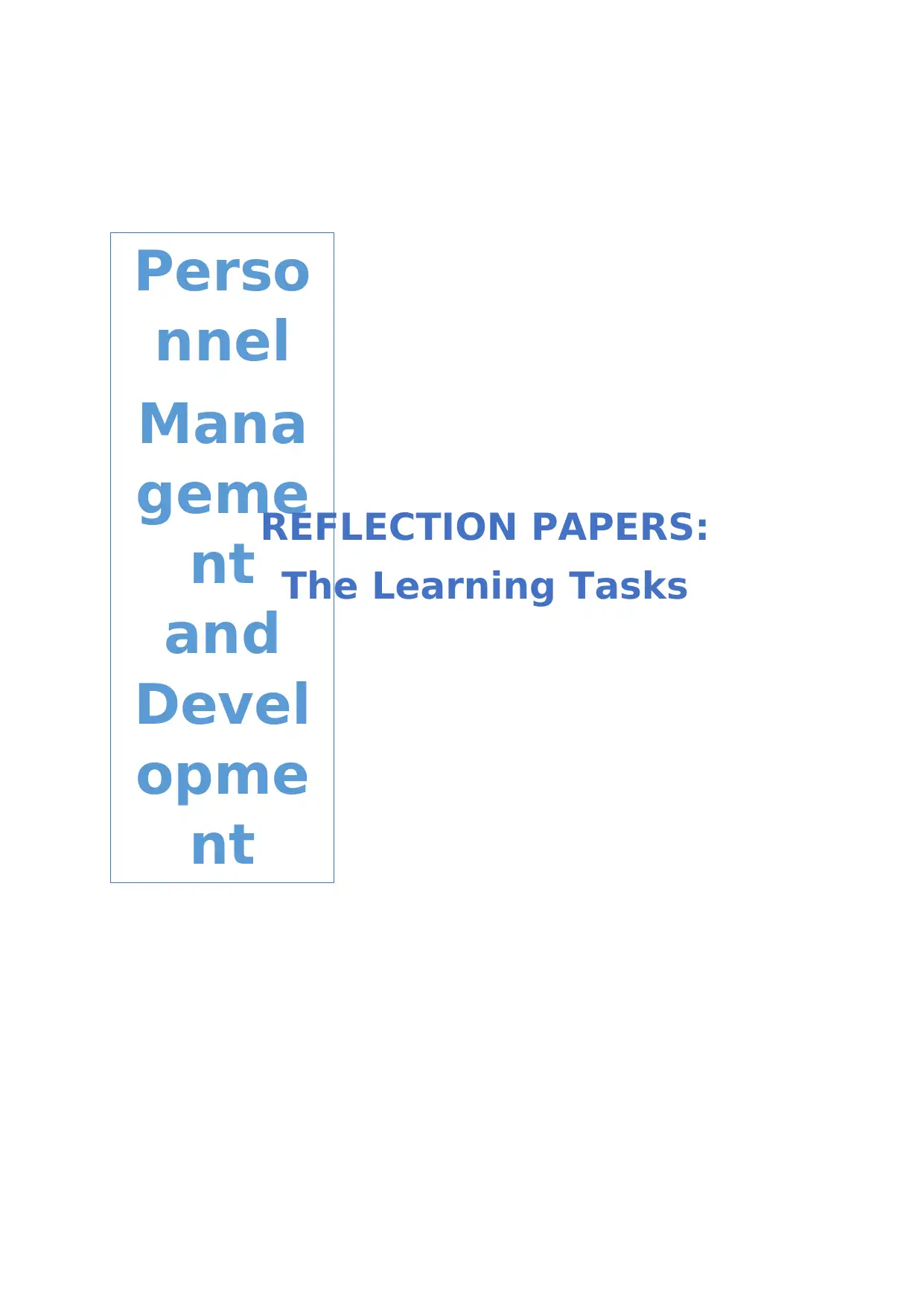
Perso
nnel
Mana
geme
nt
and
Devel
opme
nt
REFLECTION PAPERS:
The Learning Tasks
nnel
Mana
geme
nt
and
Devel
opme
nt
REFLECTION PAPERS:
The Learning Tasks
Paraphrase This Document
Need a fresh take? Get an instant paraphrase of this document with our AI Paraphraser
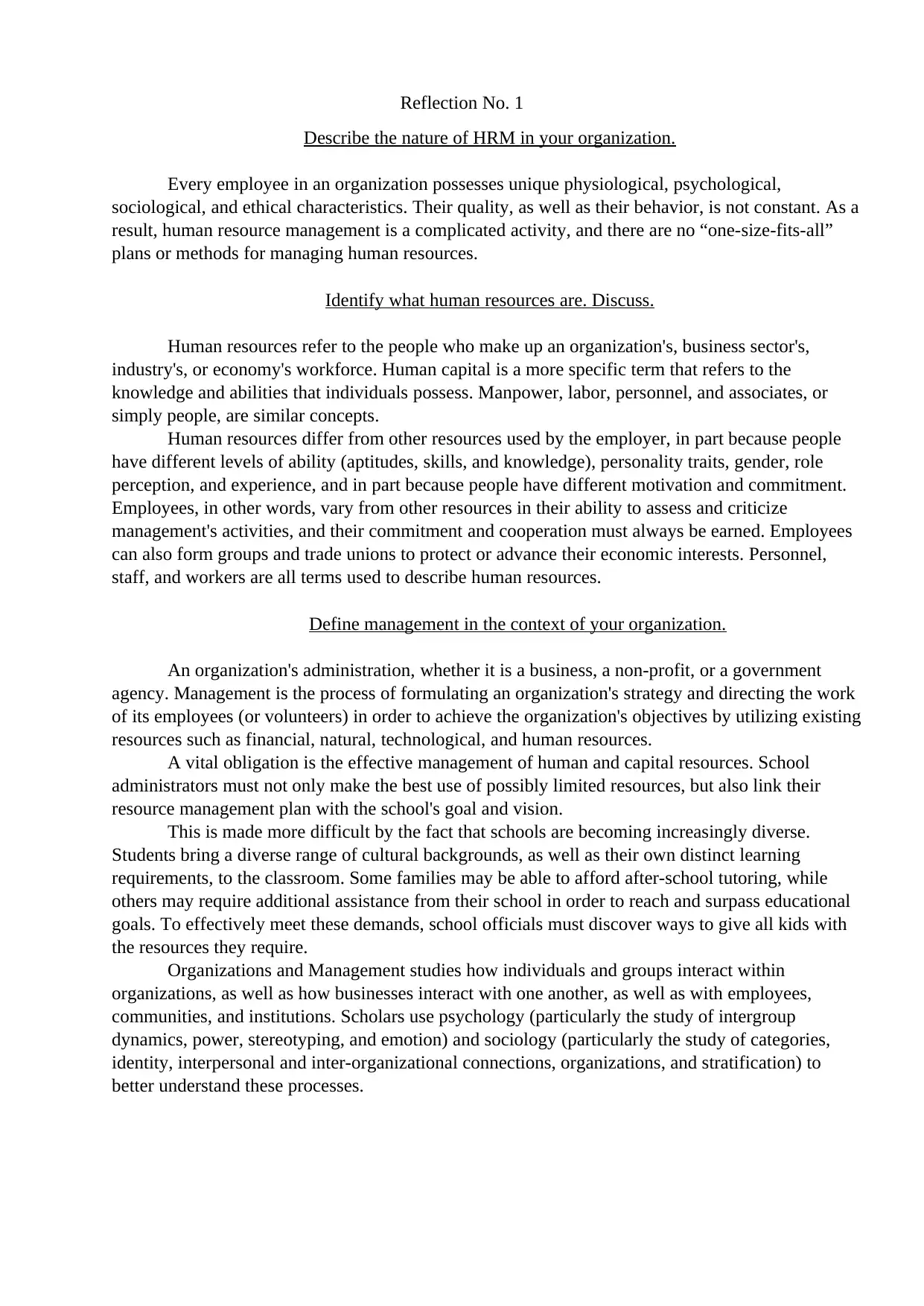
Reflection No. 1
Describe the nature of HRM in your organization.
Every employee in an organization possesses unique physiological, psychological,
sociological, and ethical characteristics. Their quality, as well as their behavior, is not constant. As a
result, human resource management is a complicated activity, and there are no “one-size-fits-all”
plans or methods for managing human resources.
Identify what human resources are. Discuss.
Human resources refer to the people who make up an organization's, business sector's,
industry's, or economy's workforce. Human capital is a more specific term that refers to the
knowledge and abilities that individuals possess. Manpower, labor, personnel, and associates, or
simply people, are similar concepts.
Human resources differ from other resources used by the employer, in part because people
have different levels of ability (aptitudes, skills, and knowledge), personality traits, gender, role
perception, and experience, and in part because people have different motivation and commitment.
Employees, in other words, vary from other resources in their ability to assess and criticize
management's activities, and their commitment and cooperation must always be earned. Employees
can also form groups and trade unions to protect or advance their economic interests. Personnel,
staff, and workers are all terms used to describe human resources.
Define management in the context of your organization.
An organization's administration, whether it is a business, a non-profit, or a government
agency. Management is the process of formulating an organization's strategy and directing the work
of its employees (or volunteers) in order to achieve the organization's objectives by utilizing existing
resources such as financial, natural, technological, and human resources.
A vital obligation is the effective management of human and capital resources. School
administrators must not only make the best use of possibly limited resources, but also link their
resource management plan with the school's goal and vision.
This is made more difficult by the fact that schools are becoming increasingly diverse.
Students bring a diverse range of cultural backgrounds, as well as their own distinct learning
requirements, to the classroom. Some families may be able to afford after-school tutoring, while
others may require additional assistance from their school in order to reach and surpass educational
goals. To effectively meet these demands, school officials must discover ways to give all kids with
the resources they require.
Organizations and Management studies how individuals and groups interact within
organizations, as well as how businesses interact with one another, as well as with employees,
communities, and institutions. Scholars use psychology (particularly the study of intergroup
dynamics, power, stereotyping, and emotion) and sociology (particularly the study of categories,
identity, interpersonal and inter-organizational connections, organizations, and stratification) to
better understand these processes.
Describe the nature of HRM in your organization.
Every employee in an organization possesses unique physiological, psychological,
sociological, and ethical characteristics. Their quality, as well as their behavior, is not constant. As a
result, human resource management is a complicated activity, and there are no “one-size-fits-all”
plans or methods for managing human resources.
Identify what human resources are. Discuss.
Human resources refer to the people who make up an organization's, business sector's,
industry's, or economy's workforce. Human capital is a more specific term that refers to the
knowledge and abilities that individuals possess. Manpower, labor, personnel, and associates, or
simply people, are similar concepts.
Human resources differ from other resources used by the employer, in part because people
have different levels of ability (aptitudes, skills, and knowledge), personality traits, gender, role
perception, and experience, and in part because people have different motivation and commitment.
Employees, in other words, vary from other resources in their ability to assess and criticize
management's activities, and their commitment and cooperation must always be earned. Employees
can also form groups and trade unions to protect or advance their economic interests. Personnel,
staff, and workers are all terms used to describe human resources.
Define management in the context of your organization.
An organization's administration, whether it is a business, a non-profit, or a government
agency. Management is the process of formulating an organization's strategy and directing the work
of its employees (or volunteers) in order to achieve the organization's objectives by utilizing existing
resources such as financial, natural, technological, and human resources.
A vital obligation is the effective management of human and capital resources. School
administrators must not only make the best use of possibly limited resources, but also link their
resource management plan with the school's goal and vision.
This is made more difficult by the fact that schools are becoming increasingly diverse.
Students bring a diverse range of cultural backgrounds, as well as their own distinct learning
requirements, to the classroom. Some families may be able to afford after-school tutoring, while
others may require additional assistance from their school in order to reach and surpass educational
goals. To effectively meet these demands, school officials must discover ways to give all kids with
the resources they require.
Organizations and Management studies how individuals and groups interact within
organizations, as well as how businesses interact with one another, as well as with employees,
communities, and institutions. Scholars use psychology (particularly the study of intergroup
dynamics, power, stereotyping, and emotion) and sociology (particularly the study of categories,
identity, interpersonal and inter-organizational connections, organizations, and stratification) to
better understand these processes.
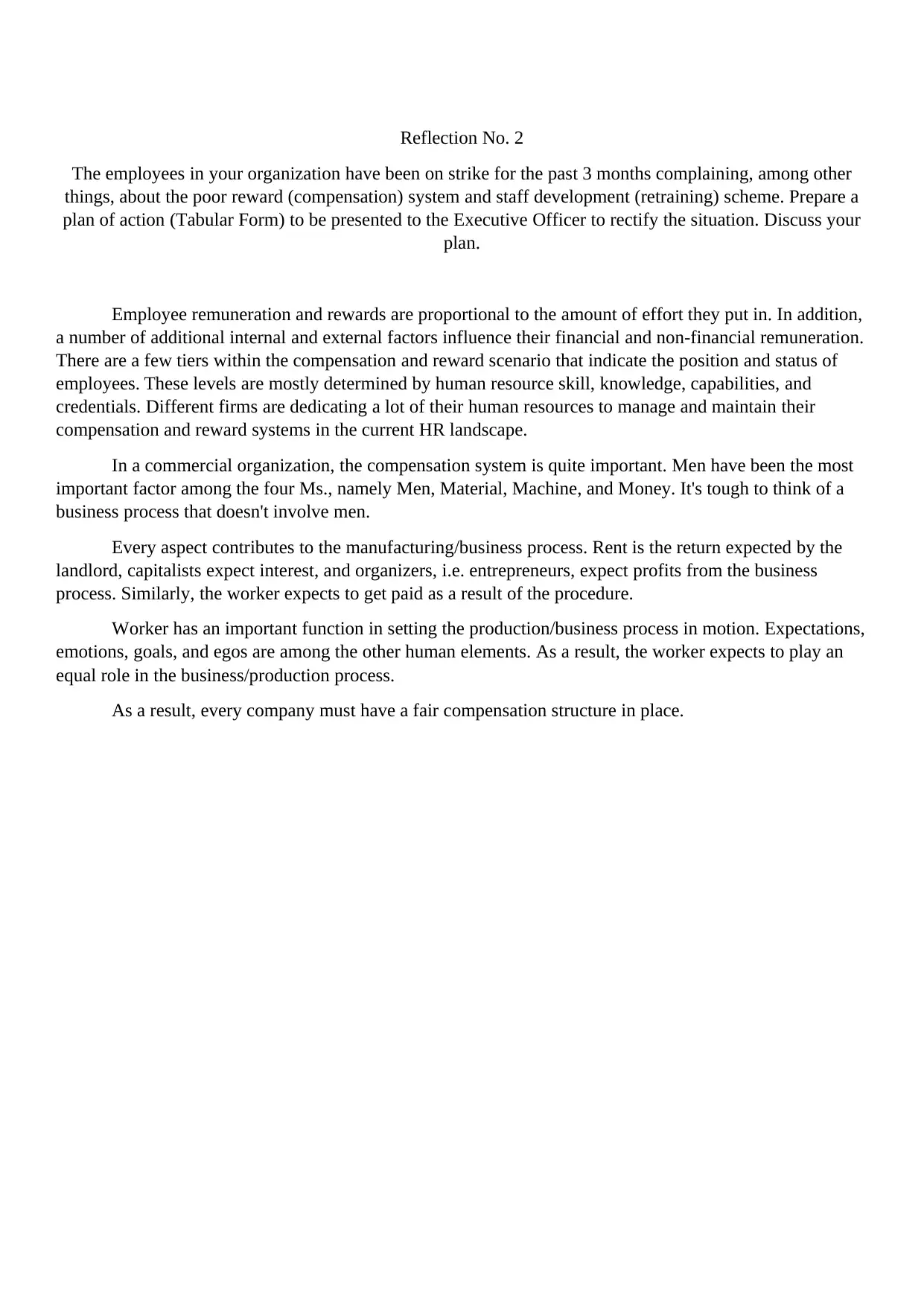
Reflection No. 2
The employees in your organization have been on strike for the past 3 months complaining, among other
things, about the poor reward (compensation) system and staff development (retraining) scheme. Prepare a
plan of action (Tabular Form) to be presented to the Executive Officer to rectify the situation. Discuss your
plan.
Employee remuneration and rewards are proportional to the amount of effort they put in. In addition,
a number of additional internal and external factors influence their financial and non-financial remuneration.
There are a few tiers within the compensation and reward scenario that indicate the position and status of
employees. These levels are mostly determined by human resource skill, knowledge, capabilities, and
credentials. Different firms are dedicating a lot of their human resources to manage and maintain their
compensation and reward systems in the current HR landscape.
In a commercial organization, the compensation system is quite important. Men have been the most
important factor among the four Ms., namely Men, Material, Machine, and Money. It's tough to think of a
business process that doesn't involve men.
Every aspect contributes to the manufacturing/business process. Rent is the return expected by the
landlord, capitalists expect interest, and organizers, i.e. entrepreneurs, expect profits from the business
process. Similarly, the worker expects to get paid as a result of the procedure.
Worker has an important function in setting the production/business process in motion. Expectations,
emotions, goals, and egos are among the other human elements. As a result, the worker expects to play an
equal role in the business/production process.
As a result, every company must have a fair compensation structure in place.
The employees in your organization have been on strike for the past 3 months complaining, among other
things, about the poor reward (compensation) system and staff development (retraining) scheme. Prepare a
plan of action (Tabular Form) to be presented to the Executive Officer to rectify the situation. Discuss your
plan.
Employee remuneration and rewards are proportional to the amount of effort they put in. In addition,
a number of additional internal and external factors influence their financial and non-financial remuneration.
There are a few tiers within the compensation and reward scenario that indicate the position and status of
employees. These levels are mostly determined by human resource skill, knowledge, capabilities, and
credentials. Different firms are dedicating a lot of their human resources to manage and maintain their
compensation and reward systems in the current HR landscape.
In a commercial organization, the compensation system is quite important. Men have been the most
important factor among the four Ms., namely Men, Material, Machine, and Money. It's tough to think of a
business process that doesn't involve men.
Every aspect contributes to the manufacturing/business process. Rent is the return expected by the
landlord, capitalists expect interest, and organizers, i.e. entrepreneurs, expect profits from the business
process. Similarly, the worker expects to get paid as a result of the procedure.
Worker has an important function in setting the production/business process in motion. Expectations,
emotions, goals, and egos are among the other human elements. As a result, the worker expects to play an
equal role in the business/production process.
As a result, every company must have a fair compensation structure in place.
⊘ This is a preview!⊘
Do you want full access?
Subscribe today to unlock all pages.

Trusted by 1+ million students worldwide
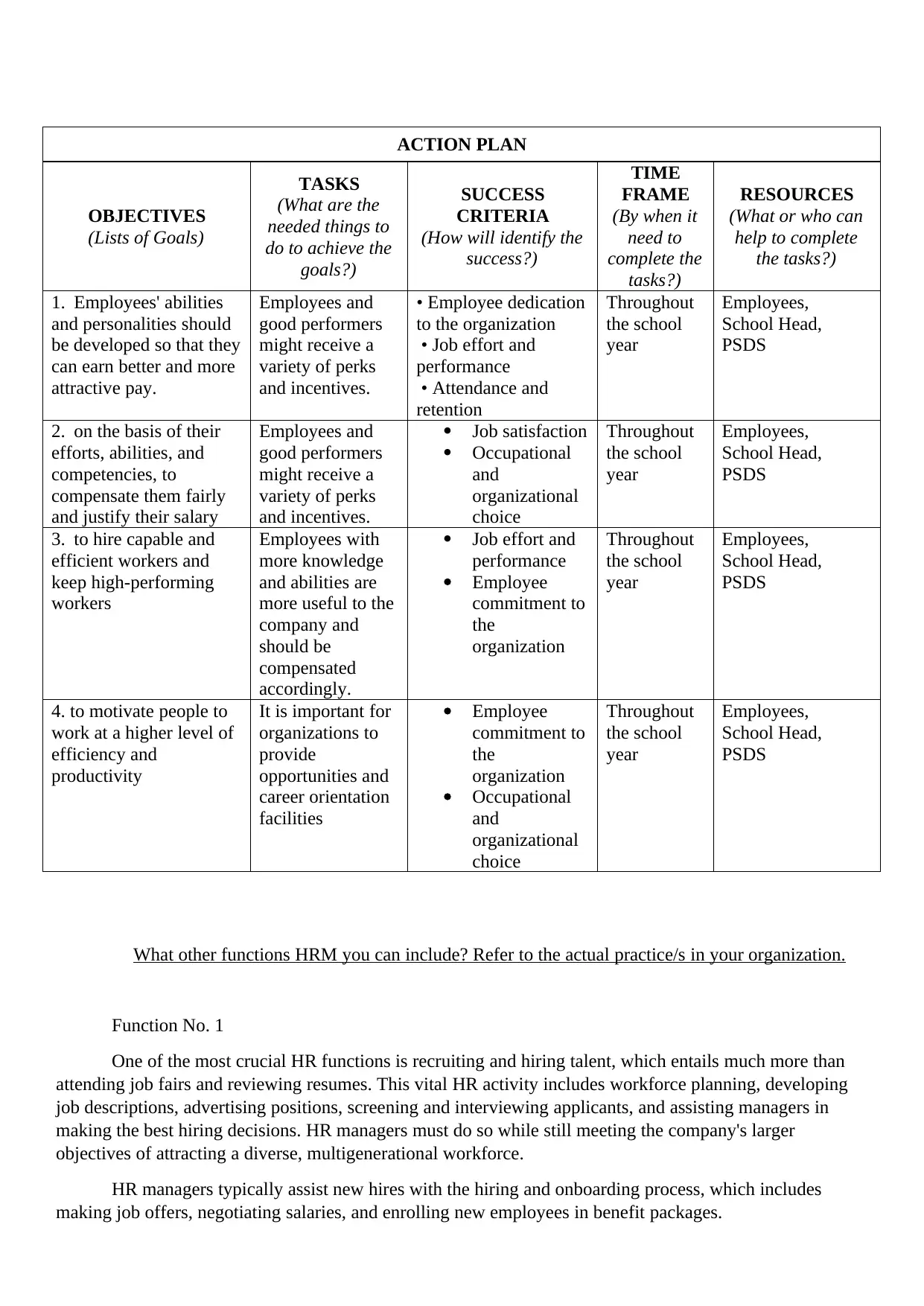
ACTION PLAN
OBJECTIVES
(Lists of Goals)
TASKS
(What are the
needed things to
do to achieve the
goals?)
SUCCESS
CRITERIA
(How will identify the
success?)
TIME
FRAME
(By when it
need to
complete the
tasks?)
RESOURCES
(What or who can
help to complete
the tasks?)
1. Employees' abilities
and personalities should
be developed so that they
can earn better and more
attractive pay.
Employees and
good performers
might receive a
variety of perks
and incentives.
• Employee dedication
to the organization
• Job effort and
performance
• Attendance and
retention
Throughout
the school
year
Employees,
School Head,
PSDS
2. on the basis of their
efforts, abilities, and
competencies, to
compensate them fairly
and justify their salary
Employees and
good performers
might receive a
variety of perks
and incentives.
Job satisfaction
Occupational
and
organizational
choice
Throughout
the school
year
Employees,
School Head,
PSDS
3. to hire capable and
efficient workers and
keep high-performing
workers
Employees with
more knowledge
and abilities are
more useful to the
company and
should be
compensated
accordingly.
Job effort and
performance
Employee
commitment to
the
organization
Throughout
the school
year
Employees,
School Head,
PSDS
4. to motivate people to
work at a higher level of
efficiency and
productivity
It is important for
organizations to
provide
opportunities and
career orientation
facilities
Employee
commitment to
the
organization
Occupational
and
organizational
choice
Throughout
the school
year
Employees,
School Head,
PSDS
What other functions HRM you can include? Refer to the actual practice/s in your organization.
Function No. 1
One of the most crucial HR functions is recruiting and hiring talent, which entails much more than
attending job fairs and reviewing resumes. This vital HR activity includes workforce planning, developing
job descriptions, advertising positions, screening and interviewing applicants, and assisting managers in
making the best hiring decisions. HR managers must do so while still meeting the company's larger
objectives of attracting a diverse, multigenerational workforce.
HR managers typically assist new hires with the hiring and onboarding process, which includes
making job offers, negotiating salaries, and enrolling new employees in benefit packages.
OBJECTIVES
(Lists of Goals)
TASKS
(What are the
needed things to
do to achieve the
goals?)
SUCCESS
CRITERIA
(How will identify the
success?)
TIME
FRAME
(By when it
need to
complete the
tasks?)
RESOURCES
(What or who can
help to complete
the tasks?)
1. Employees' abilities
and personalities should
be developed so that they
can earn better and more
attractive pay.
Employees and
good performers
might receive a
variety of perks
and incentives.
• Employee dedication
to the organization
• Job effort and
performance
• Attendance and
retention
Throughout
the school
year
Employees,
School Head,
PSDS
2. on the basis of their
efforts, abilities, and
competencies, to
compensate them fairly
and justify their salary
Employees and
good performers
might receive a
variety of perks
and incentives.
Job satisfaction
Occupational
and
organizational
choice
Throughout
the school
year
Employees,
School Head,
PSDS
3. to hire capable and
efficient workers and
keep high-performing
workers
Employees with
more knowledge
and abilities are
more useful to the
company and
should be
compensated
accordingly.
Job effort and
performance
Employee
commitment to
the
organization
Throughout
the school
year
Employees,
School Head,
PSDS
4. to motivate people to
work at a higher level of
efficiency and
productivity
It is important for
organizations to
provide
opportunities and
career orientation
facilities
Employee
commitment to
the
organization
Occupational
and
organizational
choice
Throughout
the school
year
Employees,
School Head,
PSDS
What other functions HRM you can include? Refer to the actual practice/s in your organization.
Function No. 1
One of the most crucial HR functions is recruiting and hiring talent, which entails much more than
attending job fairs and reviewing resumes. This vital HR activity includes workforce planning, developing
job descriptions, advertising positions, screening and interviewing applicants, and assisting managers in
making the best hiring decisions. HR managers must do so while still meeting the company's larger
objectives of attracting a diverse, multigenerational workforce.
HR managers typically assist new hires with the hiring and onboarding process, which includes
making job offers, negotiating salaries, and enrolling new employees in benefit packages.
Paraphrase This Document
Need a fresh take? Get an instant paraphrase of this document with our AI Paraphraser
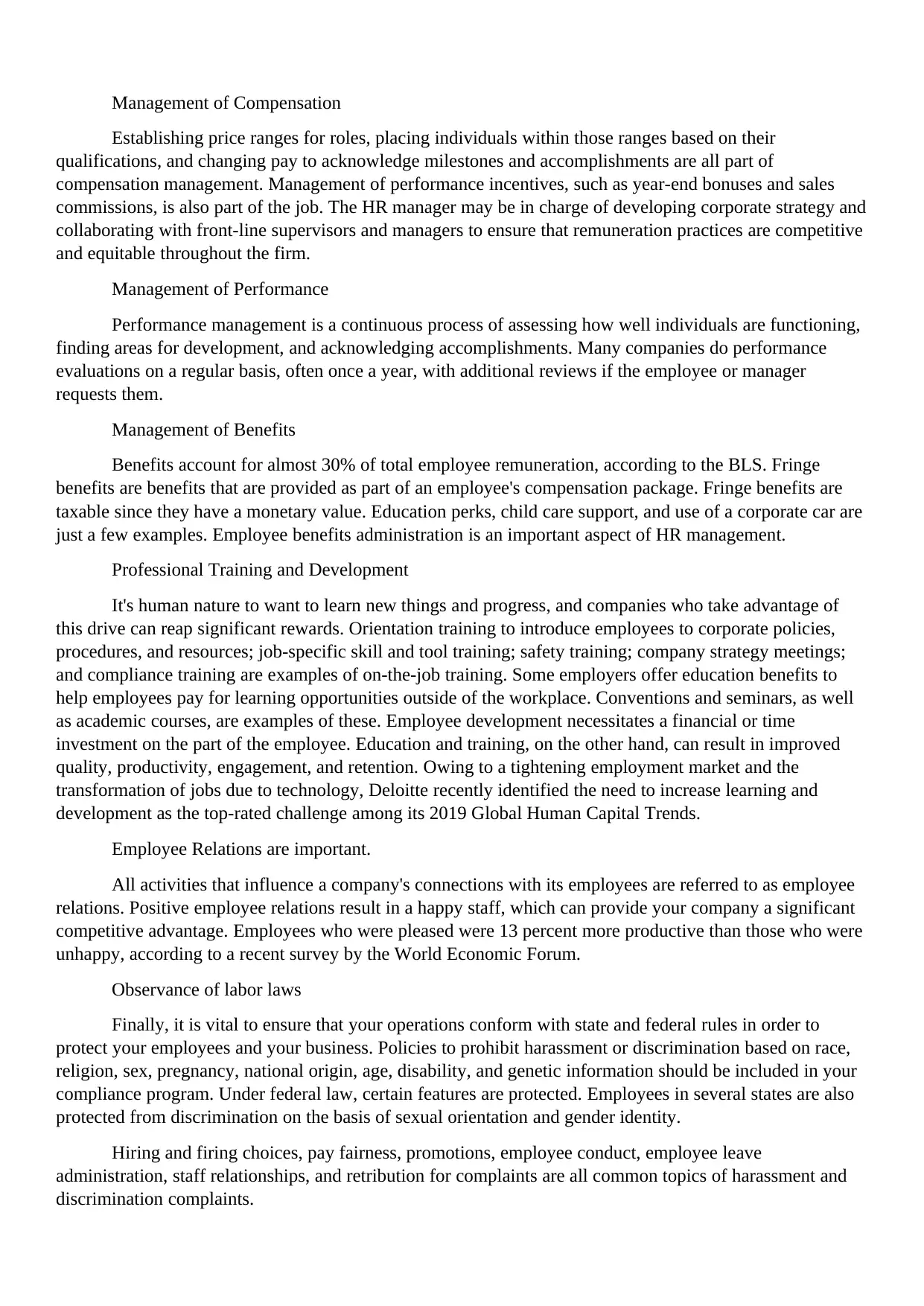
Management of Compensation
Establishing price ranges for roles, placing individuals within those ranges based on their
qualifications, and changing pay to acknowledge milestones and accomplishments are all part of
compensation management. Management of performance incentives, such as year-end bonuses and sales
commissions, is also part of the job. The HR manager may be in charge of developing corporate strategy and
collaborating with front-line supervisors and managers to ensure that remuneration practices are competitive
and equitable throughout the firm.
Management of Performance
Performance management is a continuous process of assessing how well individuals are functioning,
finding areas for development, and acknowledging accomplishments. Many companies do performance
evaluations on a regular basis, often once a year, with additional reviews if the employee or manager
requests them.
Management of Benefits
Benefits account for almost 30% of total employee remuneration, according to the BLS. Fringe
benefits are benefits that are provided as part of an employee's compensation package. Fringe benefits are
taxable since they have a monetary value. Education perks, child care support, and use of a corporate car are
just a few examples. Employee benefits administration is an important aspect of HR management.
Professional Training and Development
It's human nature to want to learn new things and progress, and companies who take advantage of
this drive can reap significant rewards. Orientation training to introduce employees to corporate policies,
procedures, and resources; job-specific skill and tool training; safety training; company strategy meetings;
and compliance training are examples of on-the-job training. Some employers offer education benefits to
help employees pay for learning opportunities outside of the workplace. Conventions and seminars, as well
as academic courses, are examples of these. Employee development necessitates a financial or time
investment on the part of the employee. Education and training, on the other hand, can result in improved
quality, productivity, engagement, and retention. Owing to a tightening employment market and the
transformation of jobs due to technology, Deloitte recently identified the need to increase learning and
development as the top-rated challenge among its 2019 Global Human Capital Trends.
Employee Relations are important.
All activities that influence a company's connections with its employees are referred to as employee
relations. Positive employee relations result in a happy staff, which can provide your company a significant
competitive advantage. Employees who were pleased were 13 percent more productive than those who were
unhappy, according to a recent survey by the World Economic Forum.
Observance of labor laws
Finally, it is vital to ensure that your operations conform with state and federal rules in order to
protect your employees and your business. Policies to prohibit harassment or discrimination based on race,
religion, sex, pregnancy, national origin, age, disability, and genetic information should be included in your
compliance program. Under federal law, certain features are protected. Employees in several states are also
protected from discrimination on the basis of sexual orientation and gender identity.
Hiring and firing choices, pay fairness, promotions, employee conduct, employee leave
administration, staff relationships, and retribution for complaints are all common topics of harassment and
discrimination complaints.
Establishing price ranges for roles, placing individuals within those ranges based on their
qualifications, and changing pay to acknowledge milestones and accomplishments are all part of
compensation management. Management of performance incentives, such as year-end bonuses and sales
commissions, is also part of the job. The HR manager may be in charge of developing corporate strategy and
collaborating with front-line supervisors and managers to ensure that remuneration practices are competitive
and equitable throughout the firm.
Management of Performance
Performance management is a continuous process of assessing how well individuals are functioning,
finding areas for development, and acknowledging accomplishments. Many companies do performance
evaluations on a regular basis, often once a year, with additional reviews if the employee or manager
requests them.
Management of Benefits
Benefits account for almost 30% of total employee remuneration, according to the BLS. Fringe
benefits are benefits that are provided as part of an employee's compensation package. Fringe benefits are
taxable since they have a monetary value. Education perks, child care support, and use of a corporate car are
just a few examples. Employee benefits administration is an important aspect of HR management.
Professional Training and Development
It's human nature to want to learn new things and progress, and companies who take advantage of
this drive can reap significant rewards. Orientation training to introduce employees to corporate policies,
procedures, and resources; job-specific skill and tool training; safety training; company strategy meetings;
and compliance training are examples of on-the-job training. Some employers offer education benefits to
help employees pay for learning opportunities outside of the workplace. Conventions and seminars, as well
as academic courses, are examples of these. Employee development necessitates a financial or time
investment on the part of the employee. Education and training, on the other hand, can result in improved
quality, productivity, engagement, and retention. Owing to a tightening employment market and the
transformation of jobs due to technology, Deloitte recently identified the need to increase learning and
development as the top-rated challenge among its 2019 Global Human Capital Trends.
Employee Relations are important.
All activities that influence a company's connections with its employees are referred to as employee
relations. Positive employee relations result in a happy staff, which can provide your company a significant
competitive advantage. Employees who were pleased were 13 percent more productive than those who were
unhappy, according to a recent survey by the World Economic Forum.
Observance of labor laws
Finally, it is vital to ensure that your operations conform with state and federal rules in order to
protect your employees and your business. Policies to prohibit harassment or discrimination based on race,
religion, sex, pregnancy, national origin, age, disability, and genetic information should be included in your
compliance program. Under federal law, certain features are protected. Employees in several states are also
protected from discrimination on the basis of sexual orientation and gender identity.
Hiring and firing choices, pay fairness, promotions, employee conduct, employee leave
administration, staff relationships, and retribution for complaints are all common topics of harassment and
discrimination complaints.
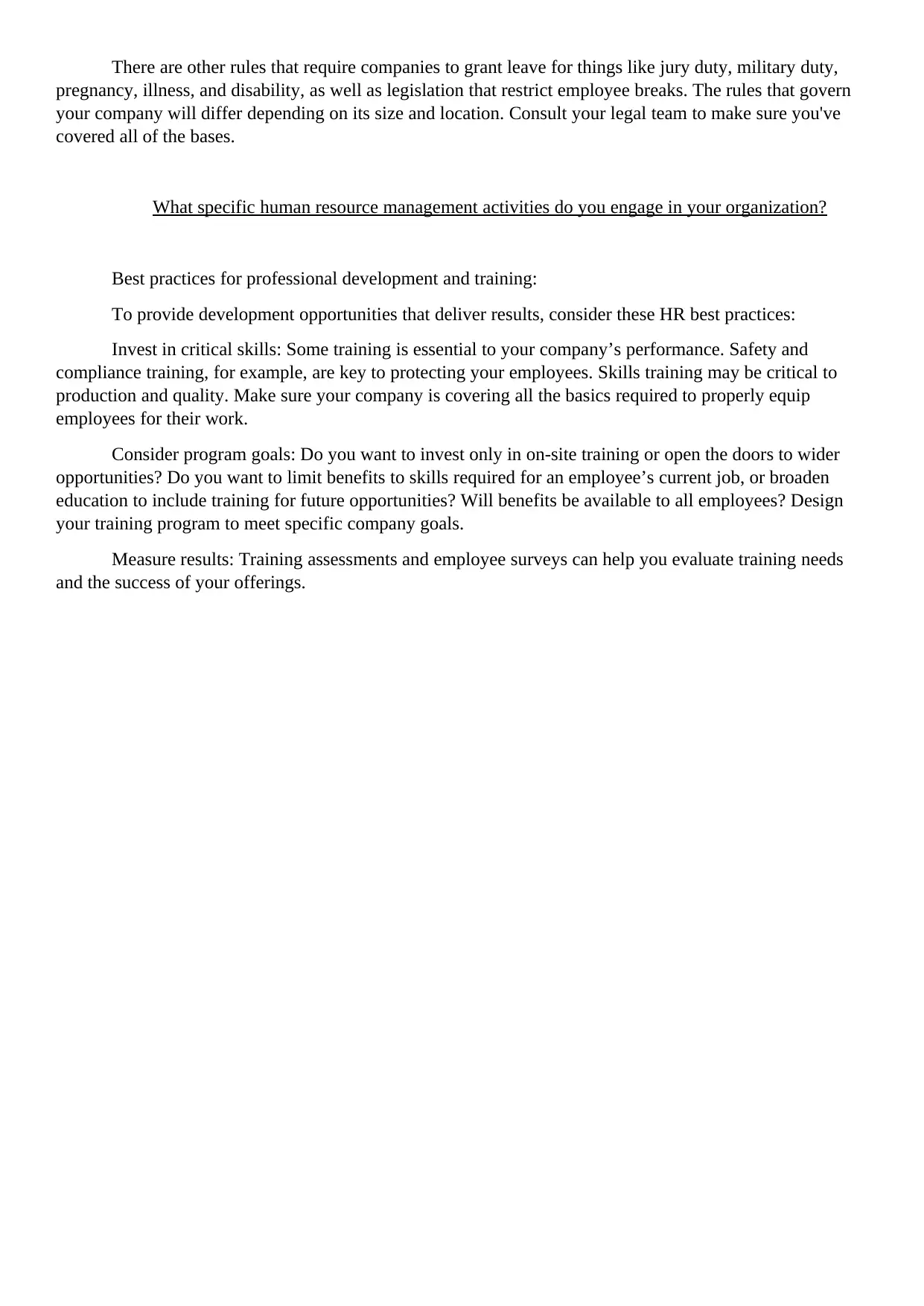
There are other rules that require companies to grant leave for things like jury duty, military duty,
pregnancy, illness, and disability, as well as legislation that restrict employee breaks. The rules that govern
your company will differ depending on its size and location. Consult your legal team to make sure you've
covered all of the bases.
What specific human resource management activities do you engage in your organization?
Best practices for professional development and training:
To provide development opportunities that deliver results, consider these HR best practices:
Invest in critical skills: Some training is essential to your company’s performance. Safety and
compliance training, for example, are key to protecting your employees. Skills training may be critical to
production and quality. Make sure your company is covering all the basics required to properly equip
employees for their work.
Consider program goals: Do you want to invest only in on-site training or open the doors to wider
opportunities? Do you want to limit benefits to skills required for an employee’s current job, or broaden
education to include training for future opportunities? Will benefits be available to all employees? Design
your training program to meet specific company goals.
Measure results: Training assessments and employee surveys can help you evaluate training needs
and the success of your offerings.
pregnancy, illness, and disability, as well as legislation that restrict employee breaks. The rules that govern
your company will differ depending on its size and location. Consult your legal team to make sure you've
covered all of the bases.
What specific human resource management activities do you engage in your organization?
Best practices for professional development and training:
To provide development opportunities that deliver results, consider these HR best practices:
Invest in critical skills: Some training is essential to your company’s performance. Safety and
compliance training, for example, are key to protecting your employees. Skills training may be critical to
production and quality. Make sure your company is covering all the basics required to properly equip
employees for their work.
Consider program goals: Do you want to invest only in on-site training or open the doors to wider
opportunities? Do you want to limit benefits to skills required for an employee’s current job, or broaden
education to include training for future opportunities? Will benefits be available to all employees? Design
your training program to meet specific company goals.
Measure results: Training assessments and employee surveys can help you evaluate training needs
and the success of your offerings.
⊘ This is a preview!⊘
Do you want full access?
Subscribe today to unlock all pages.

Trusted by 1+ million students worldwide
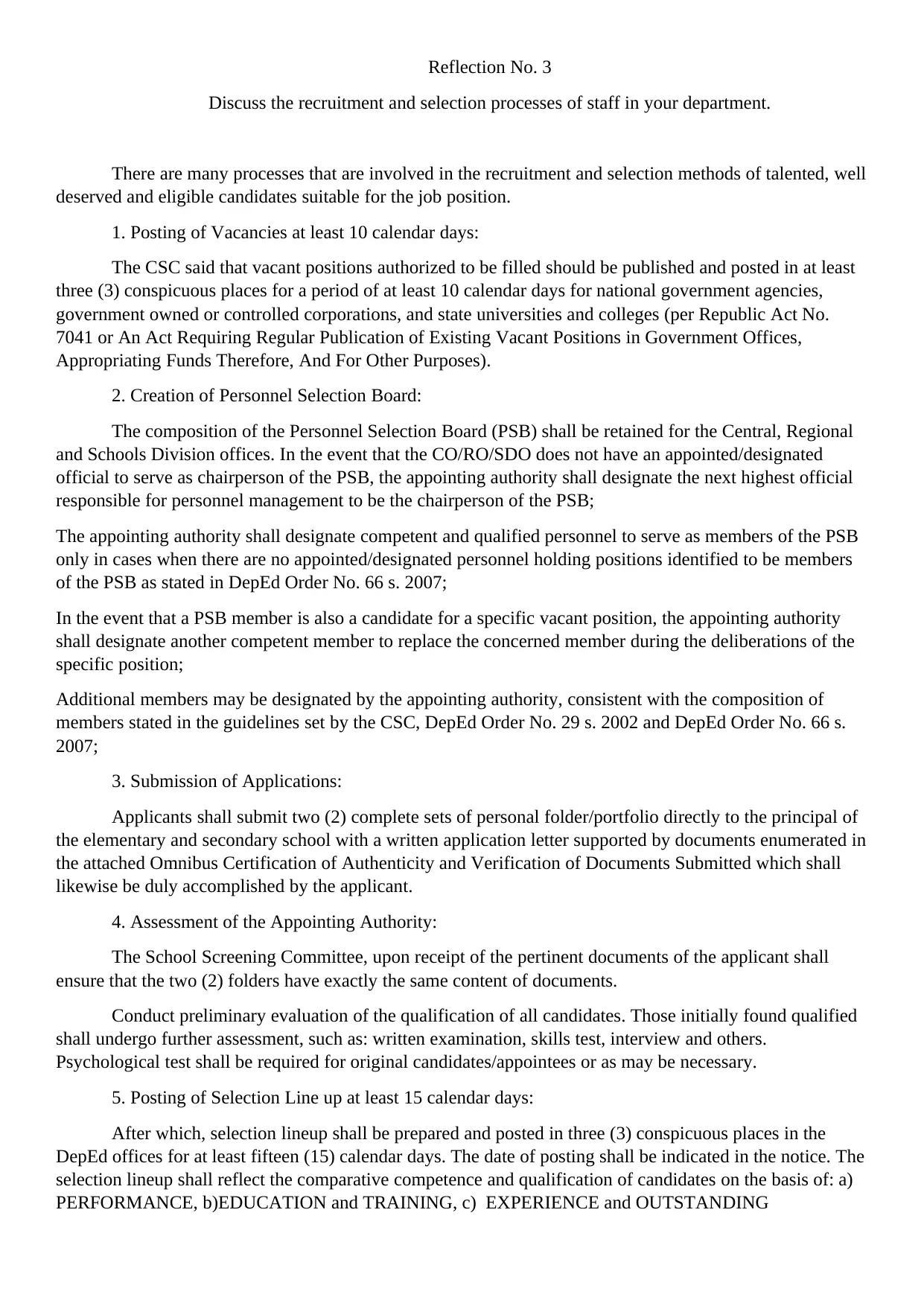
Reflection No. 3
Discuss the recruitment and selection processes of staff in your department.
There are many processes that are involved in the recruitment and selection methods of talented, well
deserved and eligible candidates suitable for the job position.
1. Posting of Vacancies at least 10 calendar days:
The CSC said that vacant positions authorized to be filled should be published and posted in at least
three (3) conspicuous places for a period of at least 10 calendar days for national government agencies,
government owned or controlled corporations, and state universities and colleges (per Republic Act No.
7041 or An Act Requiring Regular Publication of Existing Vacant Positions in Government Offices,
Appropriating Funds Therefore, And For Other Purposes).
2. Creation of Personnel Selection Board:
The composition of the Personnel Selection Board (PSB) shall be retained for the Central, Regional
and Schools Division offices. In the event that the CO/RO/SDO does not have an appointed/designated
official to serve as chairperson of the PSB, the appointing authority shall designate the next highest official
responsible for personnel management to be the chairperson of the PSB;
The appointing authority shall designate competent and qualified personnel to serve as members of the PSB
only in cases when there are no appointed/designated personnel holding positions identified to be members
of the PSB as stated in DepEd Order No. 66 s. 2007;
In the event that a PSB member is also a candidate for a specific vacant position, the appointing authority
shall designate another competent member to replace the concerned member during the deliberations of the
specific position;
Additional members may be designated by the appointing authority, consistent with the composition of
members stated in the guidelines set by the CSC, DepEd Order No. 29 s. 2002 and DepEd Order No. 66 s.
2007;
3. Submission of Applications:
Applicants shall submit two (2) complete sets of personal folder/portfolio directly to the principal of
the elementary and secondary school with a written application letter supported by documents enumerated in
the attached Omnibus Certification of Authenticity and Verification of Documents Submitted which shall
likewise be duly accomplished by the applicant.
4. Assessment of the Appointing Authority:
The School Screening Committee, upon receipt of the pertinent documents of the applicant shall
ensure that the two (2) folders have exactly the same content of documents.
Conduct preliminary evaluation of the qualification of all candidates. Those initially found qualified
shall undergo further assessment, such as: written examination, skills test, interview and others.
Psychological test shall be required for original candidates/appointees or as may be necessary.
5. Posting of Selection Line up at least 15 calendar days:
After which, selection lineup shall be prepared and posted in three (3) conspicuous places in the
DepEd offices for at least fifteen (15) calendar days. The date of posting shall be indicated in the notice. The
selection lineup shall reflect the comparative competence and qualification of candidates on the basis of: a)
PERFORMANCE, b)EDUCATION and TRAINING, c) EXPERIENCE and OUTSTANDING
Discuss the recruitment and selection processes of staff in your department.
There are many processes that are involved in the recruitment and selection methods of talented, well
deserved and eligible candidates suitable for the job position.
1. Posting of Vacancies at least 10 calendar days:
The CSC said that vacant positions authorized to be filled should be published and posted in at least
three (3) conspicuous places for a period of at least 10 calendar days for national government agencies,
government owned or controlled corporations, and state universities and colleges (per Republic Act No.
7041 or An Act Requiring Regular Publication of Existing Vacant Positions in Government Offices,
Appropriating Funds Therefore, And For Other Purposes).
2. Creation of Personnel Selection Board:
The composition of the Personnel Selection Board (PSB) shall be retained for the Central, Regional
and Schools Division offices. In the event that the CO/RO/SDO does not have an appointed/designated
official to serve as chairperson of the PSB, the appointing authority shall designate the next highest official
responsible for personnel management to be the chairperson of the PSB;
The appointing authority shall designate competent and qualified personnel to serve as members of the PSB
only in cases when there are no appointed/designated personnel holding positions identified to be members
of the PSB as stated in DepEd Order No. 66 s. 2007;
In the event that a PSB member is also a candidate for a specific vacant position, the appointing authority
shall designate another competent member to replace the concerned member during the deliberations of the
specific position;
Additional members may be designated by the appointing authority, consistent with the composition of
members stated in the guidelines set by the CSC, DepEd Order No. 29 s. 2002 and DepEd Order No. 66 s.
2007;
3. Submission of Applications:
Applicants shall submit two (2) complete sets of personal folder/portfolio directly to the principal of
the elementary and secondary school with a written application letter supported by documents enumerated in
the attached Omnibus Certification of Authenticity and Verification of Documents Submitted which shall
likewise be duly accomplished by the applicant.
4. Assessment of the Appointing Authority:
The School Screening Committee, upon receipt of the pertinent documents of the applicant shall
ensure that the two (2) folders have exactly the same content of documents.
Conduct preliminary evaluation of the qualification of all candidates. Those initially found qualified
shall undergo further assessment, such as: written examination, skills test, interview and others.
Psychological test shall be required for original candidates/appointees or as may be necessary.
5. Posting of Selection Line up at least 15 calendar days:
After which, selection lineup shall be prepared and posted in three (3) conspicuous places in the
DepEd offices for at least fifteen (15) calendar days. The date of posting shall be indicated in the notice. The
selection lineup shall reflect the comparative competence and qualification of candidates on the basis of: a)
PERFORMANCE, b)EDUCATION and TRAINING, c) EXPERIENCE and OUTSTANDING
Paraphrase This Document
Need a fresh take? Get an instant paraphrase of this document with our AI Paraphraser
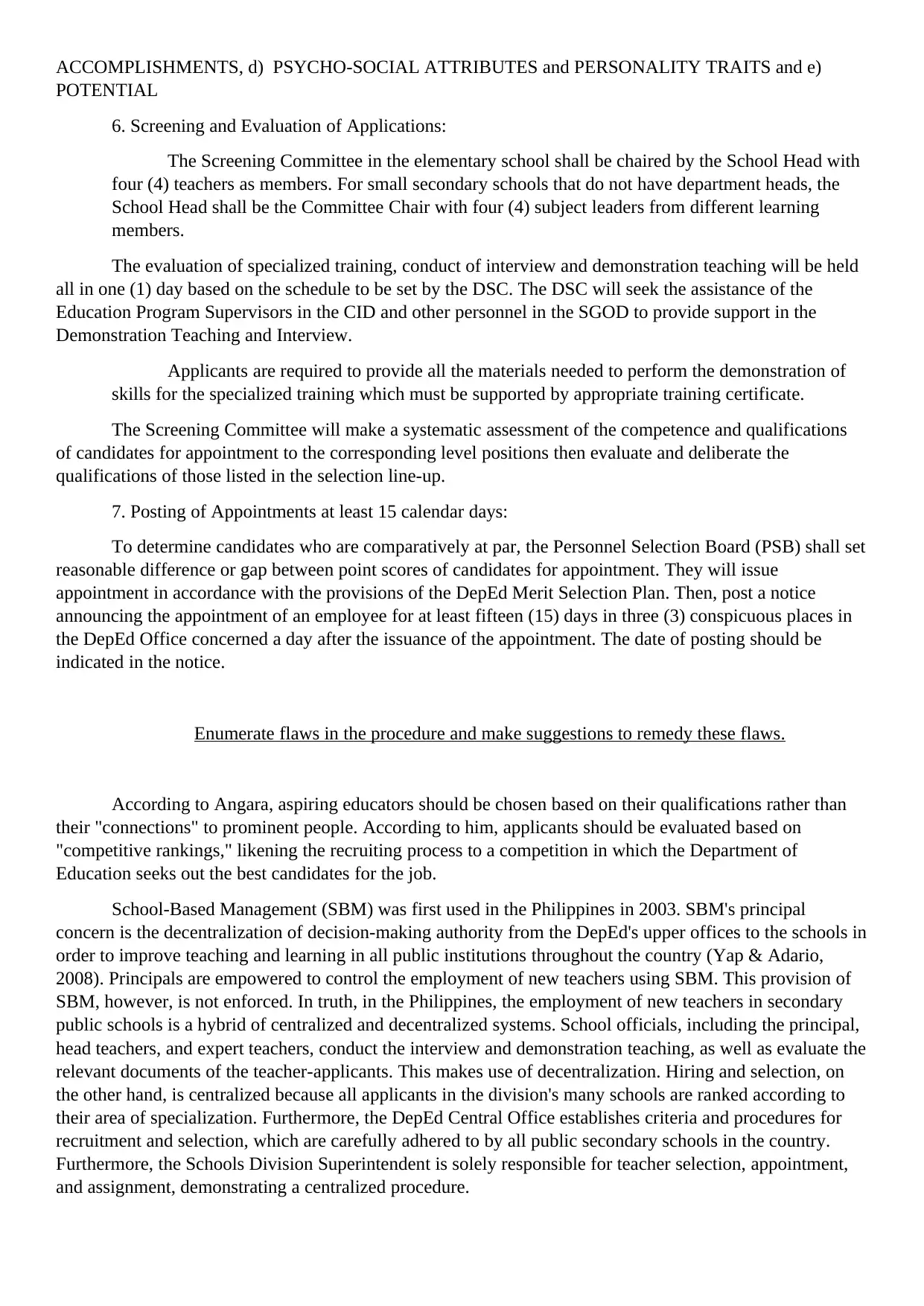
ACCOMPLISHMENTS, d) PSYCHO-SOCIAL ATTRIBUTES and PERSONALITY TRAITS and e)
POTENTIAL
6. Screening and Evaluation of Applications:
The Screening Committee in the elementary school shall be chaired by the School Head with
four (4) teachers as members. For small secondary schools that do not have department heads, the
School Head shall be the Committee Chair with four (4) subject leaders from different learning
members.
The evaluation of specialized training, conduct of interview and demonstration teaching will be held
all in one (1) day based on the schedule to be set by the DSC. The DSC will seek the assistance of the
Education Program Supervisors in the CID and other personnel in the SGOD to provide support in the
Demonstration Teaching and Interview.
Applicants are required to provide all the materials needed to perform the demonstration of
skills for the specialized training which must be supported by appropriate training certificate.
The Screening Committee will make a systematic assessment of the competence and qualifications
of candidates for appointment to the corresponding level positions then evaluate and deliberate the
qualifications of those listed in the selection line-up.
7. Posting of Appointments at least 15 calendar days:
To determine candidates who are comparatively at par, the Personnel Selection Board (PSB) shall set
reasonable difference or gap between point scores of candidates for appointment. They will issue
appointment in accordance with the provisions of the DepEd Merit Selection Plan. Then, post a notice
announcing the appointment of an employee for at least fifteen (15) days in three (3) conspicuous places in
the DepEd Office concerned a day after the issuance of the appointment. The date of posting should be
indicated in the notice.
Enumerate flaws in the procedure and make suggestions to remedy these flaws.
According to Angara, aspiring educators should be chosen based on their qualifications rather than
their "connections" to prominent people. According to him, applicants should be evaluated based on
"competitive rankings," likening the recruiting process to a competition in which the Department of
Education seeks out the best candidates for the job.
School-Based Management (SBM) was first used in the Philippines in 2003. SBM's principal
concern is the decentralization of decision-making authority from the DepEd's upper offices to the schools in
order to improve teaching and learning in all public institutions throughout the country (Yap & Adario,
2008). Principals are empowered to control the employment of new teachers using SBM. This provision of
SBM, however, is not enforced. In truth, in the Philippines, the employment of new teachers in secondary
public schools is a hybrid of centralized and decentralized systems. School officials, including the principal,
head teachers, and expert teachers, conduct the interview and demonstration teaching, as well as evaluate the
relevant documents of the teacher-applicants. This makes use of decentralization. Hiring and selection, on
the other hand, is centralized because all applicants in the division's many schools are ranked according to
their area of specialization. Furthermore, the DepEd Central Office establishes criteria and procedures for
recruitment and selection, which are carefully adhered to by all public secondary schools in the country.
Furthermore, the Schools Division Superintendent is solely responsible for teacher selection, appointment,
and assignment, demonstrating a centralized procedure.
POTENTIAL
6. Screening and Evaluation of Applications:
The Screening Committee in the elementary school shall be chaired by the School Head with
four (4) teachers as members. For small secondary schools that do not have department heads, the
School Head shall be the Committee Chair with four (4) subject leaders from different learning
members.
The evaluation of specialized training, conduct of interview and demonstration teaching will be held
all in one (1) day based on the schedule to be set by the DSC. The DSC will seek the assistance of the
Education Program Supervisors in the CID and other personnel in the SGOD to provide support in the
Demonstration Teaching and Interview.
Applicants are required to provide all the materials needed to perform the demonstration of
skills for the specialized training which must be supported by appropriate training certificate.
The Screening Committee will make a systematic assessment of the competence and qualifications
of candidates for appointment to the corresponding level positions then evaluate and deliberate the
qualifications of those listed in the selection line-up.
7. Posting of Appointments at least 15 calendar days:
To determine candidates who are comparatively at par, the Personnel Selection Board (PSB) shall set
reasonable difference or gap between point scores of candidates for appointment. They will issue
appointment in accordance with the provisions of the DepEd Merit Selection Plan. Then, post a notice
announcing the appointment of an employee for at least fifteen (15) days in three (3) conspicuous places in
the DepEd Office concerned a day after the issuance of the appointment. The date of posting should be
indicated in the notice.
Enumerate flaws in the procedure and make suggestions to remedy these flaws.
According to Angara, aspiring educators should be chosen based on their qualifications rather than
their "connections" to prominent people. According to him, applicants should be evaluated based on
"competitive rankings," likening the recruiting process to a competition in which the Department of
Education seeks out the best candidates for the job.
School-Based Management (SBM) was first used in the Philippines in 2003. SBM's principal
concern is the decentralization of decision-making authority from the DepEd's upper offices to the schools in
order to improve teaching and learning in all public institutions throughout the country (Yap & Adario,
2008). Principals are empowered to control the employment of new teachers using SBM. This provision of
SBM, however, is not enforced. In truth, in the Philippines, the employment of new teachers in secondary
public schools is a hybrid of centralized and decentralized systems. School officials, including the principal,
head teachers, and expert teachers, conduct the interview and demonstration teaching, as well as evaluate the
relevant documents of the teacher-applicants. This makes use of decentralization. Hiring and selection, on
the other hand, is centralized because all applicants in the division's many schools are ranked according to
their area of specialization. Furthermore, the DepEd Central Office establishes criteria and procedures for
recruitment and selection, which are carefully adhered to by all public secondary schools in the country.
Furthermore, the Schools Division Superintendent is solely responsible for teacher selection, appointment,
and assignment, demonstrating a centralized procedure.
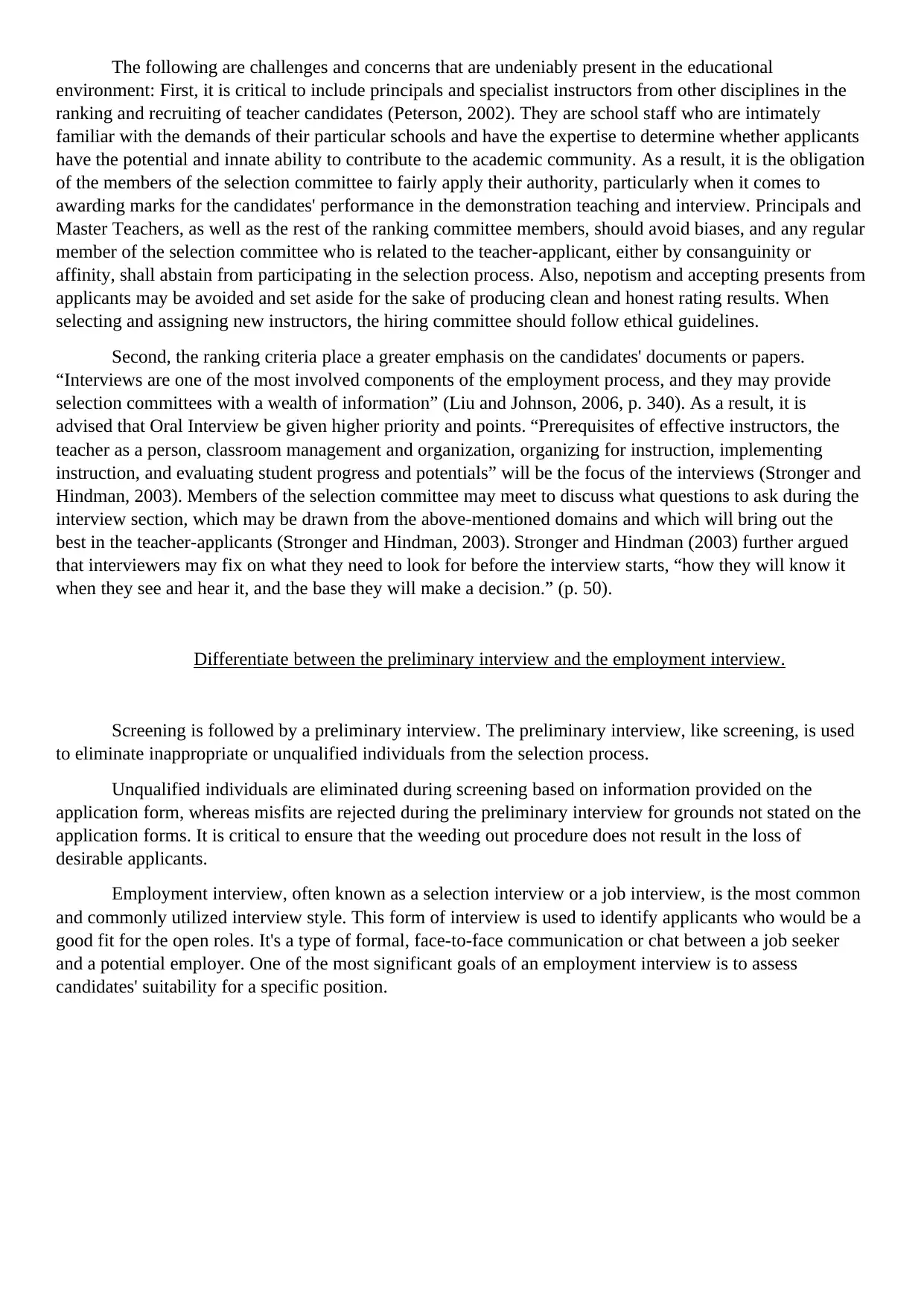
The following are challenges and concerns that are undeniably present in the educational
environment: First, it is critical to include principals and specialist instructors from other disciplines in the
ranking and recruiting of teacher candidates (Peterson, 2002). They are school staff who are intimately
familiar with the demands of their particular schools and have the expertise to determine whether applicants
have the potential and innate ability to contribute to the academic community. As a result, it is the obligation
of the members of the selection committee to fairly apply their authority, particularly when it comes to
awarding marks for the candidates' performance in the demonstration teaching and interview. Principals and
Master Teachers, as well as the rest of the ranking committee members, should avoid biases, and any regular
member of the selection committee who is related to the teacher-applicant, either by consanguinity or
affinity, shall abstain from participating in the selection process. Also, nepotism and accepting presents from
applicants may be avoided and set aside for the sake of producing clean and honest rating results. When
selecting and assigning new instructors, the hiring committee should follow ethical guidelines.
Second, the ranking criteria place a greater emphasis on the candidates' documents or papers.
“Interviews are one of the most involved components of the employment process, and they may provide
selection committees with a wealth of information” (Liu and Johnson, 2006, p. 340). As a result, it is
advised that Oral Interview be given higher priority and points. “Prerequisites of effective instructors, the
teacher as a person, classroom management and organization, organizing for instruction, implementing
instruction, and evaluating student progress and potentials” will be the focus of the interviews (Stronger and
Hindman, 2003). Members of the selection committee may meet to discuss what questions to ask during the
interview section, which may be drawn from the above-mentioned domains and which will bring out the
best in the teacher-applicants (Stronger and Hindman, 2003). Stronger and Hindman (2003) further argued
that interviewers may fix on what they need to look for before the interview starts, “how they will know it
when they see and hear it, and the base they will make a decision.” (p. 50).
Differentiate between the preliminary interview and the employment interview.
Screening is followed by a preliminary interview. The preliminary interview, like screening, is used
to eliminate inappropriate or unqualified individuals from the selection process.
Unqualified individuals are eliminated during screening based on information provided on the
application form, whereas misfits are rejected during the preliminary interview for grounds not stated on the
application forms. It is critical to ensure that the weeding out procedure does not result in the loss of
desirable applicants.
Employment interview, often known as a selection interview or a job interview, is the most common
and commonly utilized interview style. This form of interview is used to identify applicants who would be a
good fit for the open roles. It's a type of formal, face-to-face communication or chat between a job seeker
and a potential employer. One of the most significant goals of an employment interview is to assess
candidates' suitability for a specific position.
environment: First, it is critical to include principals and specialist instructors from other disciplines in the
ranking and recruiting of teacher candidates (Peterson, 2002). They are school staff who are intimately
familiar with the demands of their particular schools and have the expertise to determine whether applicants
have the potential and innate ability to contribute to the academic community. As a result, it is the obligation
of the members of the selection committee to fairly apply their authority, particularly when it comes to
awarding marks for the candidates' performance in the demonstration teaching and interview. Principals and
Master Teachers, as well as the rest of the ranking committee members, should avoid biases, and any regular
member of the selection committee who is related to the teacher-applicant, either by consanguinity or
affinity, shall abstain from participating in the selection process. Also, nepotism and accepting presents from
applicants may be avoided and set aside for the sake of producing clean and honest rating results. When
selecting and assigning new instructors, the hiring committee should follow ethical guidelines.
Second, the ranking criteria place a greater emphasis on the candidates' documents or papers.
“Interviews are one of the most involved components of the employment process, and they may provide
selection committees with a wealth of information” (Liu and Johnson, 2006, p. 340). As a result, it is
advised that Oral Interview be given higher priority and points. “Prerequisites of effective instructors, the
teacher as a person, classroom management and organization, organizing for instruction, implementing
instruction, and evaluating student progress and potentials” will be the focus of the interviews (Stronger and
Hindman, 2003). Members of the selection committee may meet to discuss what questions to ask during the
interview section, which may be drawn from the above-mentioned domains and which will bring out the
best in the teacher-applicants (Stronger and Hindman, 2003). Stronger and Hindman (2003) further argued
that interviewers may fix on what they need to look for before the interview starts, “how they will know it
when they see and hear it, and the base they will make a decision.” (p. 50).
Differentiate between the preliminary interview and the employment interview.
Screening is followed by a preliminary interview. The preliminary interview, like screening, is used
to eliminate inappropriate or unqualified individuals from the selection process.
Unqualified individuals are eliminated during screening based on information provided on the
application form, whereas misfits are rejected during the preliminary interview for grounds not stated on the
application forms. It is critical to ensure that the weeding out procedure does not result in the loss of
desirable applicants.
Employment interview, often known as a selection interview or a job interview, is the most common
and commonly utilized interview style. This form of interview is used to identify applicants who would be a
good fit for the open roles. It's a type of formal, face-to-face communication or chat between a job seeker
and a potential employer. One of the most significant goals of an employment interview is to assess
candidates' suitability for a specific position.
⊘ This is a preview!⊘
Do you want full access?
Subscribe today to unlock all pages.

Trusted by 1+ million students worldwide
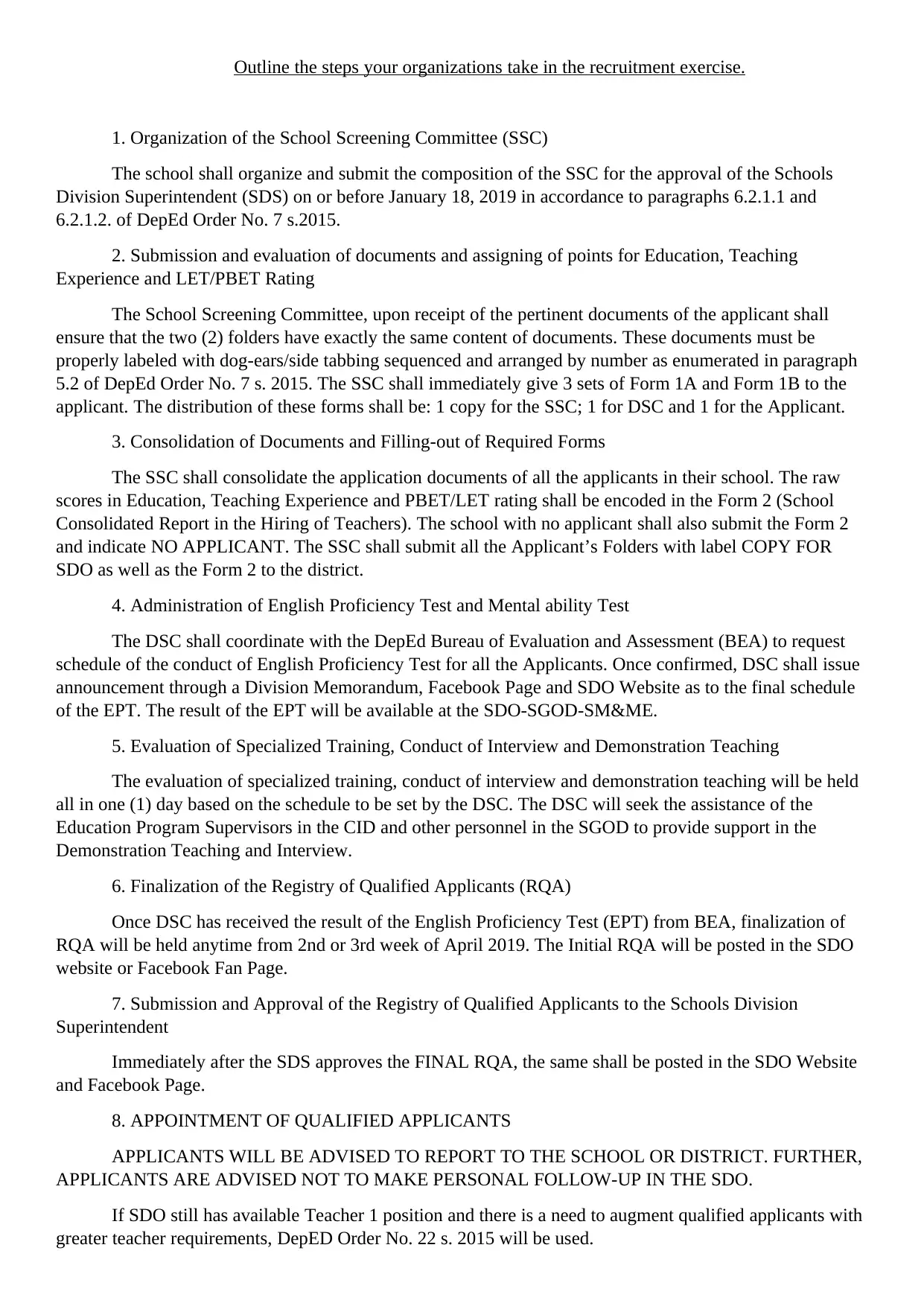
Outline the steps your organizations take in the recruitment exercise.
1. Organization of the School Screening Committee (SSC)
The school shall organize and submit the composition of the SSC for the approval of the Schools
Division Superintendent (SDS) on or before January 18, 2019 in accordance to paragraphs 6.2.1.1 and
6.2.1.2. of DepEd Order No. 7 s.2015.
2. Submission and evaluation of documents and assigning of points for Education, Teaching
Experience and LET/PBET Rating
The School Screening Committee, upon receipt of the pertinent documents of the applicant shall
ensure that the two (2) folders have exactly the same content of documents. These documents must be
properly labeled with dog-ears/side tabbing sequenced and arranged by number as enumerated in paragraph
5.2 of DepEd Order No. 7 s. 2015. The SSC shall immediately give 3 sets of Form 1A and Form 1B to the
applicant. The distribution of these forms shall be: 1 copy for the SSC; 1 for DSC and 1 for the Applicant.
3. Consolidation of Documents and Filling-out of Required Forms
The SSC shall consolidate the application documents of all the applicants in their school. The raw
scores in Education, Teaching Experience and PBET/LET rating shall be encoded in the Form 2 (School
Consolidated Report in the Hiring of Teachers). The school with no applicant shall also submit the Form 2
and indicate NO APPLICANT. The SSC shall submit all the Applicant’s Folders with label COPY FOR
SDO as well as the Form 2 to the district.
4. Administration of English Proficiency Test and Mental ability Test
The DSC shall coordinate with the DepEd Bureau of Evaluation and Assessment (BEA) to request
schedule of the conduct of English Proficiency Test for all the Applicants. Once confirmed, DSC shall issue
announcement through a Division Memorandum, Facebook Page and SDO Website as to the final schedule
of the EPT. The result of the EPT will be available at the SDO-SGOD-SM&ME.
5. Evaluation of Specialized Training, Conduct of Interview and Demonstration Teaching
The evaluation of specialized training, conduct of interview and demonstration teaching will be held
all in one (1) day based on the schedule to be set by the DSC. The DSC will seek the assistance of the
Education Program Supervisors in the CID and other personnel in the SGOD to provide support in the
Demonstration Teaching and Interview.
6. Finalization of the Registry of Qualified Applicants (RQA)
Once DSC has received the result of the English Proficiency Test (EPT) from BEA, finalization of
RQA will be held anytime from 2nd or 3rd week of April 2019. The Initial RQA will be posted in the SDO
website or Facebook Fan Page.
7. Submission and Approval of the Registry of Qualified Applicants to the Schools Division
Superintendent
Immediately after the SDS approves the FINAL RQA, the same shall be posted in the SDO Website
and Facebook Page.
8. APPOINTMENT OF QUALIFIED APPLICANTS
APPLICANTS WILL BE ADVISED TO REPORT TO THE SCHOOL OR DISTRICT. FURTHER,
APPLICANTS ARE ADVISED NOT TO MAKE PERSONAL FOLLOW-UP IN THE SDO.
If SDO still has available Teacher 1 position and there is a need to augment qualified applicants with
greater teacher requirements, DepED Order No. 22 s. 2015 will be used.
1. Organization of the School Screening Committee (SSC)
The school shall organize and submit the composition of the SSC for the approval of the Schools
Division Superintendent (SDS) on or before January 18, 2019 in accordance to paragraphs 6.2.1.1 and
6.2.1.2. of DepEd Order No. 7 s.2015.
2. Submission and evaluation of documents and assigning of points for Education, Teaching
Experience and LET/PBET Rating
The School Screening Committee, upon receipt of the pertinent documents of the applicant shall
ensure that the two (2) folders have exactly the same content of documents. These documents must be
properly labeled with dog-ears/side tabbing sequenced and arranged by number as enumerated in paragraph
5.2 of DepEd Order No. 7 s. 2015. The SSC shall immediately give 3 sets of Form 1A and Form 1B to the
applicant. The distribution of these forms shall be: 1 copy for the SSC; 1 for DSC and 1 for the Applicant.
3. Consolidation of Documents and Filling-out of Required Forms
The SSC shall consolidate the application documents of all the applicants in their school. The raw
scores in Education, Teaching Experience and PBET/LET rating shall be encoded in the Form 2 (School
Consolidated Report in the Hiring of Teachers). The school with no applicant shall also submit the Form 2
and indicate NO APPLICANT. The SSC shall submit all the Applicant’s Folders with label COPY FOR
SDO as well as the Form 2 to the district.
4. Administration of English Proficiency Test and Mental ability Test
The DSC shall coordinate with the DepEd Bureau of Evaluation and Assessment (BEA) to request
schedule of the conduct of English Proficiency Test for all the Applicants. Once confirmed, DSC shall issue
announcement through a Division Memorandum, Facebook Page and SDO Website as to the final schedule
of the EPT. The result of the EPT will be available at the SDO-SGOD-SM&ME.
5. Evaluation of Specialized Training, Conduct of Interview and Demonstration Teaching
The evaluation of specialized training, conduct of interview and demonstration teaching will be held
all in one (1) day based on the schedule to be set by the DSC. The DSC will seek the assistance of the
Education Program Supervisors in the CID and other personnel in the SGOD to provide support in the
Demonstration Teaching and Interview.
6. Finalization of the Registry of Qualified Applicants (RQA)
Once DSC has received the result of the English Proficiency Test (EPT) from BEA, finalization of
RQA will be held anytime from 2nd or 3rd week of April 2019. The Initial RQA will be posted in the SDO
website or Facebook Fan Page.
7. Submission and Approval of the Registry of Qualified Applicants to the Schools Division
Superintendent
Immediately after the SDS approves the FINAL RQA, the same shall be posted in the SDO Website
and Facebook Page.
8. APPOINTMENT OF QUALIFIED APPLICANTS
APPLICANTS WILL BE ADVISED TO REPORT TO THE SCHOOL OR DISTRICT. FURTHER,
APPLICANTS ARE ADVISED NOT TO MAKE PERSONAL FOLLOW-UP IN THE SDO.
If SDO still has available Teacher 1 position and there is a need to augment qualified applicants with
greater teacher requirements, DepED Order No. 22 s. 2015 will be used.
Paraphrase This Document
Need a fresh take? Get an instant paraphrase of this document with our AI Paraphraser
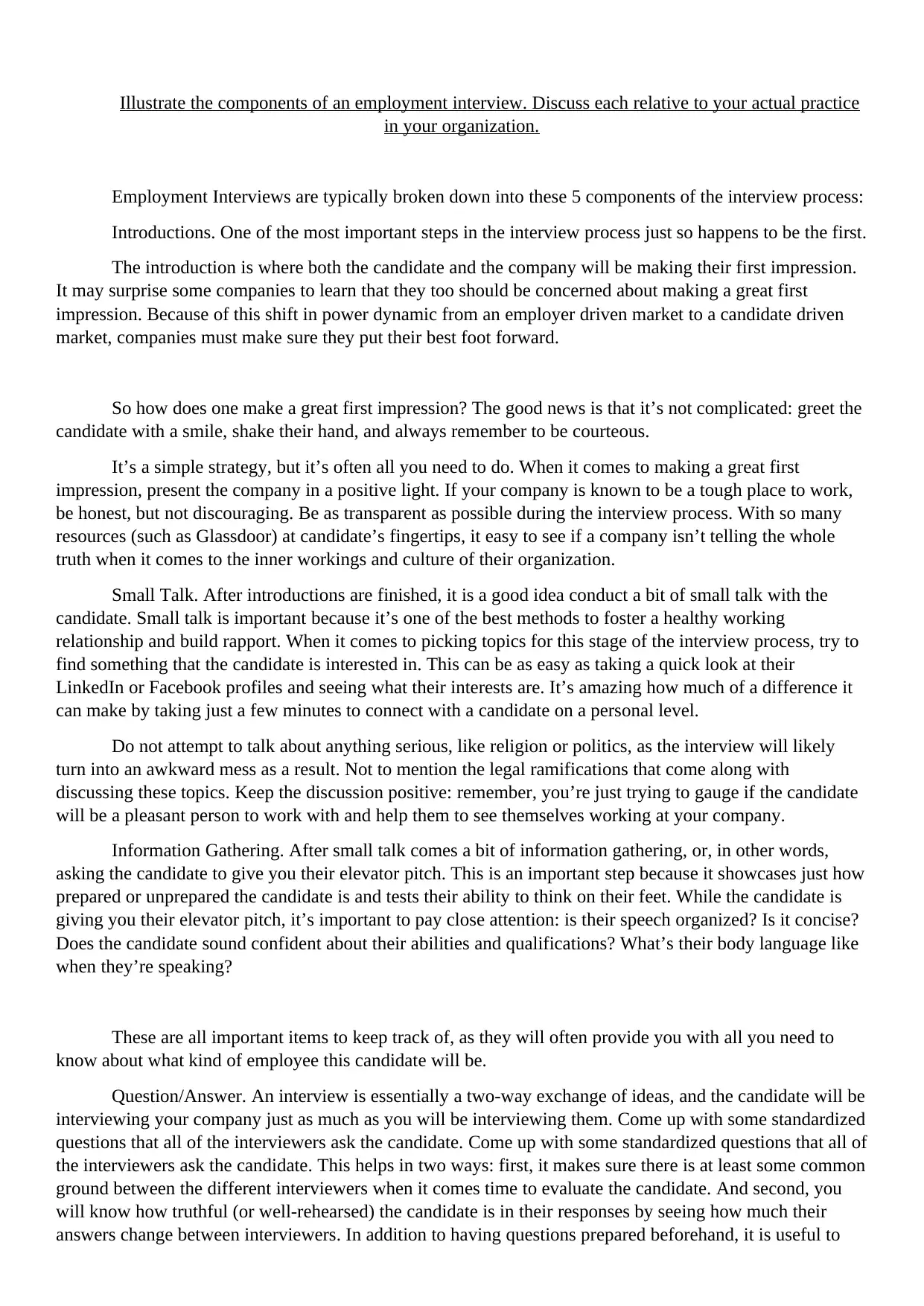
Illustrate the components of an employment interview. Discuss each relative to your actual practice
in your organization.
Employment Interviews are typically broken down into these 5 components of the interview process:
Introductions. One of the most important steps in the interview process just so happens to be the first.
The introduction is where both the candidate and the company will be making their first impression.
It may surprise some companies to learn that they too should be concerned about making a great first
impression. Because of this shift in power dynamic from an employer driven market to a candidate driven
market, companies must make sure they put their best foot forward.
So how does one make a great first impression? The good news is that it’s not complicated: greet the
candidate with a smile, shake their hand, and always remember to be courteous.
It’s a simple strategy, but it’s often all you need to do. When it comes to making a great first
impression, present the company in a positive light. If your company is known to be a tough place to work,
be honest, but not discouraging. Be as transparent as possible during the interview process. With so many
resources (such as Glassdoor) at candidate’s fingertips, it easy to see if a company isn’t telling the whole
truth when it comes to the inner workings and culture of their organization.
Small Talk. After introductions are finished, it is a good idea conduct a bit of small talk with the
candidate. Small talk is important because it’s one of the best methods to foster a healthy working
relationship and build rapport. When it comes to picking topics for this stage of the interview process, try to
find something that the candidate is interested in. This can be as easy as taking a quick look at their
LinkedIn or Facebook profiles and seeing what their interests are. It’s amazing how much of a difference it
can make by taking just a few minutes to connect with a candidate on a personal level.
Do not attempt to talk about anything serious, like religion or politics, as the interview will likely
turn into an awkward mess as a result. Not to mention the legal ramifications that come along with
discussing these topics. Keep the discussion positive: remember, you’re just trying to gauge if the candidate
will be a pleasant person to work with and help them to see themselves working at your company.
Information Gathering. After small talk comes a bit of information gathering, or, in other words,
asking the candidate to give you their elevator pitch. This is an important step because it showcases just how
prepared or unprepared the candidate is and tests their ability to think on their feet. While the candidate is
giving you their elevator pitch, it’s important to pay close attention: is their speech organized? Is it concise?
Does the candidate sound confident about their abilities and qualifications? What’s their body language like
when they’re speaking?
These are all important items to keep track of, as they will often provide you with all you need to
know about what kind of employee this candidate will be.
Question/Answer. An interview is essentially a two-way exchange of ideas, and the candidate will be
interviewing your company just as much as you will be interviewing them. Come up with some standardized
questions that all of the interviewers ask the candidate. Come up with some standardized questions that all of
the interviewers ask the candidate. This helps in two ways: first, it makes sure there is at least some common
ground between the different interviewers when it comes time to evaluate the candidate. And second, you
will know how truthful (or well-rehearsed) the candidate is in their responses by seeing how much their
answers change between interviewers. In addition to having questions prepared beforehand, it is useful to
in your organization.
Employment Interviews are typically broken down into these 5 components of the interview process:
Introductions. One of the most important steps in the interview process just so happens to be the first.
The introduction is where both the candidate and the company will be making their first impression.
It may surprise some companies to learn that they too should be concerned about making a great first
impression. Because of this shift in power dynamic from an employer driven market to a candidate driven
market, companies must make sure they put their best foot forward.
So how does one make a great first impression? The good news is that it’s not complicated: greet the
candidate with a smile, shake their hand, and always remember to be courteous.
It’s a simple strategy, but it’s often all you need to do. When it comes to making a great first
impression, present the company in a positive light. If your company is known to be a tough place to work,
be honest, but not discouraging. Be as transparent as possible during the interview process. With so many
resources (such as Glassdoor) at candidate’s fingertips, it easy to see if a company isn’t telling the whole
truth when it comes to the inner workings and culture of their organization.
Small Talk. After introductions are finished, it is a good idea conduct a bit of small talk with the
candidate. Small talk is important because it’s one of the best methods to foster a healthy working
relationship and build rapport. When it comes to picking topics for this stage of the interview process, try to
find something that the candidate is interested in. This can be as easy as taking a quick look at their
LinkedIn or Facebook profiles and seeing what their interests are. It’s amazing how much of a difference it
can make by taking just a few minutes to connect with a candidate on a personal level.
Do not attempt to talk about anything serious, like religion or politics, as the interview will likely
turn into an awkward mess as a result. Not to mention the legal ramifications that come along with
discussing these topics. Keep the discussion positive: remember, you’re just trying to gauge if the candidate
will be a pleasant person to work with and help them to see themselves working at your company.
Information Gathering. After small talk comes a bit of information gathering, or, in other words,
asking the candidate to give you their elevator pitch. This is an important step because it showcases just how
prepared or unprepared the candidate is and tests their ability to think on their feet. While the candidate is
giving you their elevator pitch, it’s important to pay close attention: is their speech organized? Is it concise?
Does the candidate sound confident about their abilities and qualifications? What’s their body language like
when they’re speaking?
These are all important items to keep track of, as they will often provide you with all you need to
know about what kind of employee this candidate will be.
Question/Answer. An interview is essentially a two-way exchange of ideas, and the candidate will be
interviewing your company just as much as you will be interviewing them. Come up with some standardized
questions that all of the interviewers ask the candidate. Come up with some standardized questions that all of
the interviewers ask the candidate. This helps in two ways: first, it makes sure there is at least some common
ground between the different interviewers when it comes time to evaluate the candidate. And second, you
will know how truthful (or well-rehearsed) the candidate is in their responses by seeing how much their
answers change between interviewers. In addition to having questions prepared beforehand, it is useful to
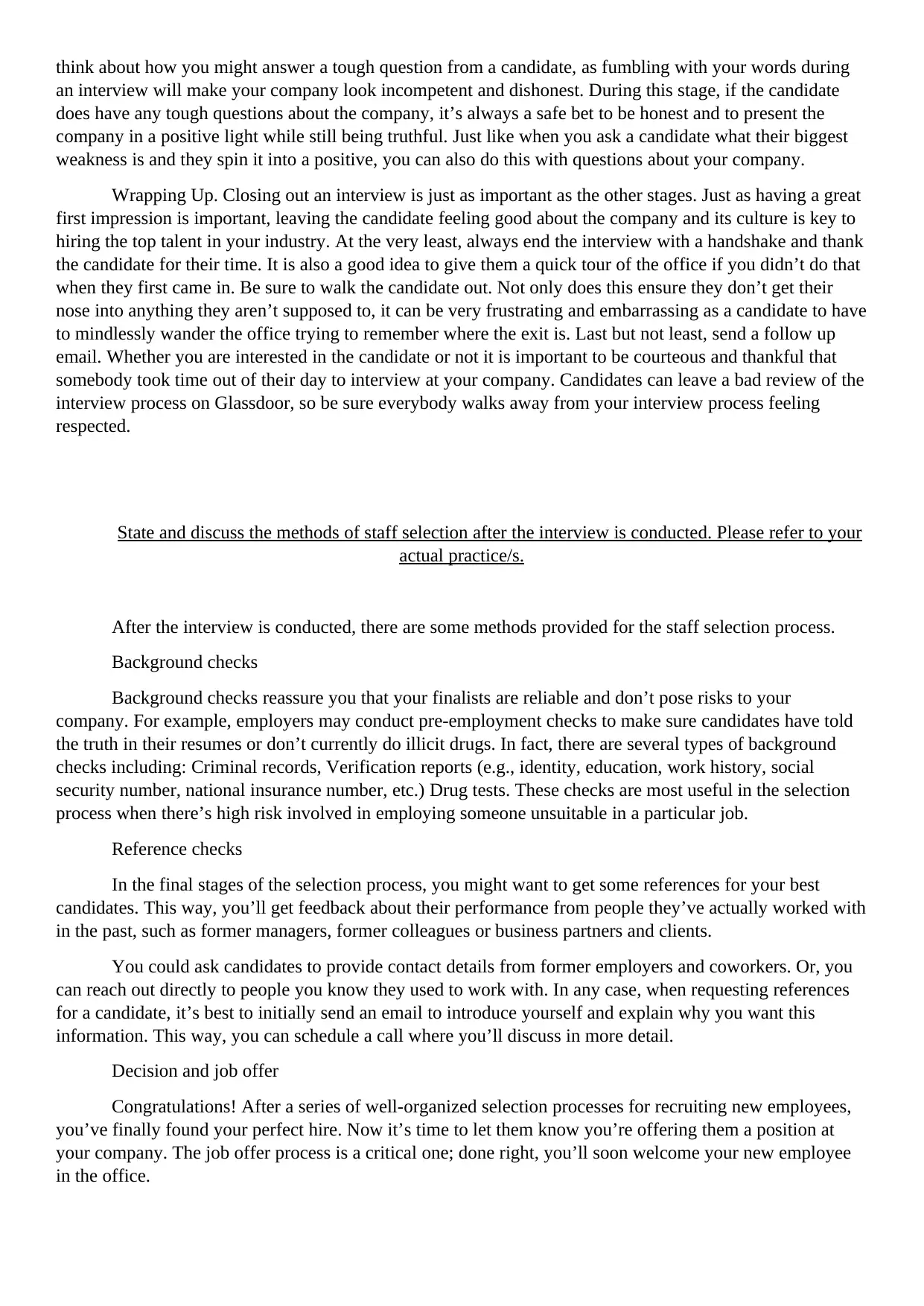
think about how you might answer a tough question from a candidate, as fumbling with your words during
an interview will make your company look incompetent and dishonest. During this stage, if the candidate
does have any tough questions about the company, it’s always a safe bet to be honest and to present the
company in a positive light while still being truthful. Just like when you ask a candidate what their biggest
weakness is and they spin it into a positive, you can also do this with questions about your company.
Wrapping Up. Closing out an interview is just as important as the other stages. Just as having a great
first impression is important, leaving the candidate feeling good about the company and its culture is key to
hiring the top talent in your industry. At the very least, always end the interview with a handshake and thank
the candidate for their time. It is also a good idea to give them a quick tour of the office if you didn’t do that
when they first came in. Be sure to walk the candidate out. Not only does this ensure they don’t get their
nose into anything they aren’t supposed to, it can be very frustrating and embarrassing as a candidate to have
to mindlessly wander the office trying to remember where the exit is. Last but not least, send a follow up
email. Whether you are interested in the candidate or not it is important to be courteous and thankful that
somebody took time out of their day to interview at your company. Candidates can leave a bad review of the
interview process on Glassdoor, so be sure everybody walks away from your interview process feeling
respected.
State and discuss the methods of staff selection after the interview is conducted. Please refer to your
actual practice/s.
After the interview is conducted, there are some methods provided for the staff selection process.
Background checks
Background checks reassure you that your finalists are reliable and don’t pose risks to your
company. For example, employers may conduct pre-employment checks to make sure candidates have told
the truth in their resumes or don’t currently do illicit drugs. In fact, there are several types of background
checks including: Criminal records, Verification reports (e.g., identity, education, work history, social
security number, national insurance number, etc.) Drug tests. These checks are most useful in the selection
process when there’s high risk involved in employing someone unsuitable in a particular job.
Reference checks
In the final stages of the selection process, you might want to get some references for your best
candidates. This way, you’ll get feedback about their performance from people they’ve actually worked with
in the past, such as former managers, former colleagues or business partners and clients.
You could ask candidates to provide contact details from former employers and coworkers. Or, you
can reach out directly to people you know they used to work with. In any case, when requesting references
for a candidate, it’s best to initially send an email to introduce yourself and explain why you want this
information. This way, you can schedule a call where you’ll discuss in more detail.
Decision and job offer
Congratulations! After a series of well-organized selection processes for recruiting new employees,
you’ve finally found your perfect hire. Now it’s time to let them know you’re offering them a position at
your company. The job offer process is a critical one; done right, you’ll soon welcome your new employee
in the office.
an interview will make your company look incompetent and dishonest. During this stage, if the candidate
does have any tough questions about the company, it’s always a safe bet to be honest and to present the
company in a positive light while still being truthful. Just like when you ask a candidate what their biggest
weakness is and they spin it into a positive, you can also do this with questions about your company.
Wrapping Up. Closing out an interview is just as important as the other stages. Just as having a great
first impression is important, leaving the candidate feeling good about the company and its culture is key to
hiring the top talent in your industry. At the very least, always end the interview with a handshake and thank
the candidate for their time. It is also a good idea to give them a quick tour of the office if you didn’t do that
when they first came in. Be sure to walk the candidate out. Not only does this ensure they don’t get their
nose into anything they aren’t supposed to, it can be very frustrating and embarrassing as a candidate to have
to mindlessly wander the office trying to remember where the exit is. Last but not least, send a follow up
email. Whether you are interested in the candidate or not it is important to be courteous and thankful that
somebody took time out of their day to interview at your company. Candidates can leave a bad review of the
interview process on Glassdoor, so be sure everybody walks away from your interview process feeling
respected.
State and discuss the methods of staff selection after the interview is conducted. Please refer to your
actual practice/s.
After the interview is conducted, there are some methods provided for the staff selection process.
Background checks
Background checks reassure you that your finalists are reliable and don’t pose risks to your
company. For example, employers may conduct pre-employment checks to make sure candidates have told
the truth in their resumes or don’t currently do illicit drugs. In fact, there are several types of background
checks including: Criminal records, Verification reports (e.g., identity, education, work history, social
security number, national insurance number, etc.) Drug tests. These checks are most useful in the selection
process when there’s high risk involved in employing someone unsuitable in a particular job.
Reference checks
In the final stages of the selection process, you might want to get some references for your best
candidates. This way, you’ll get feedback about their performance from people they’ve actually worked with
in the past, such as former managers, former colleagues or business partners and clients.
You could ask candidates to provide contact details from former employers and coworkers. Or, you
can reach out directly to people you know they used to work with. In any case, when requesting references
for a candidate, it’s best to initially send an email to introduce yourself and explain why you want this
information. This way, you can schedule a call where you’ll discuss in more detail.
Decision and job offer
Congratulations! After a series of well-organized selection processes for recruiting new employees,
you’ve finally found your perfect hire. Now it’s time to let them know you’re offering them a position at
your company. The job offer process is a critical one; done right, you’ll soon welcome your new employee
in the office.
⊘ This is a preview!⊘
Do you want full access?
Subscribe today to unlock all pages.

Trusted by 1+ million students worldwide
1 out of 43
Related Documents
Your All-in-One AI-Powered Toolkit for Academic Success.
+13062052269
info@desklib.com
Available 24*7 on WhatsApp / Email
![[object Object]](/_next/static/media/star-bottom.7253800d.svg)
Unlock your academic potential
Copyright © 2020–2025 A2Z Services. All Rights Reserved. Developed and managed by ZUCOL.





